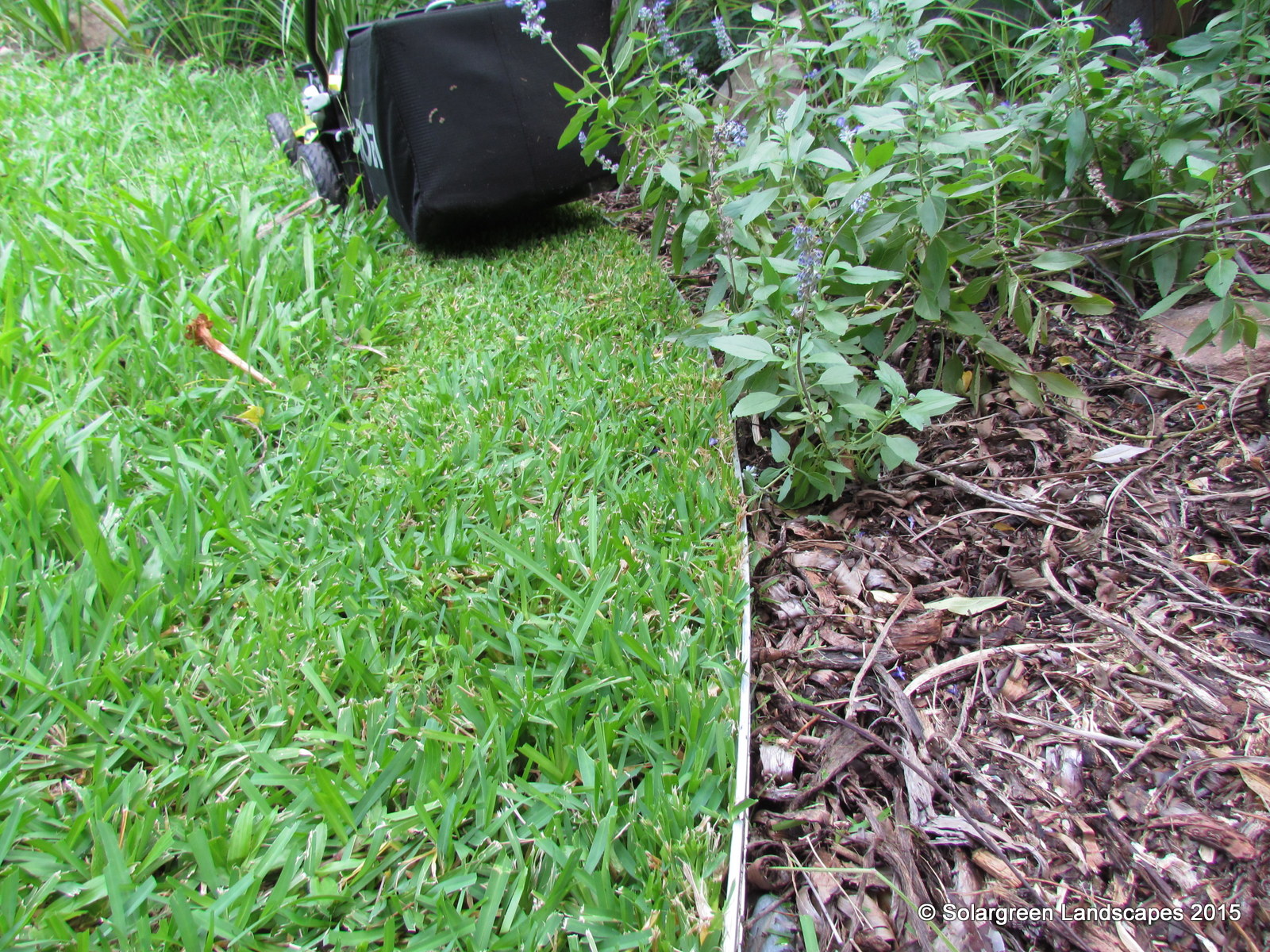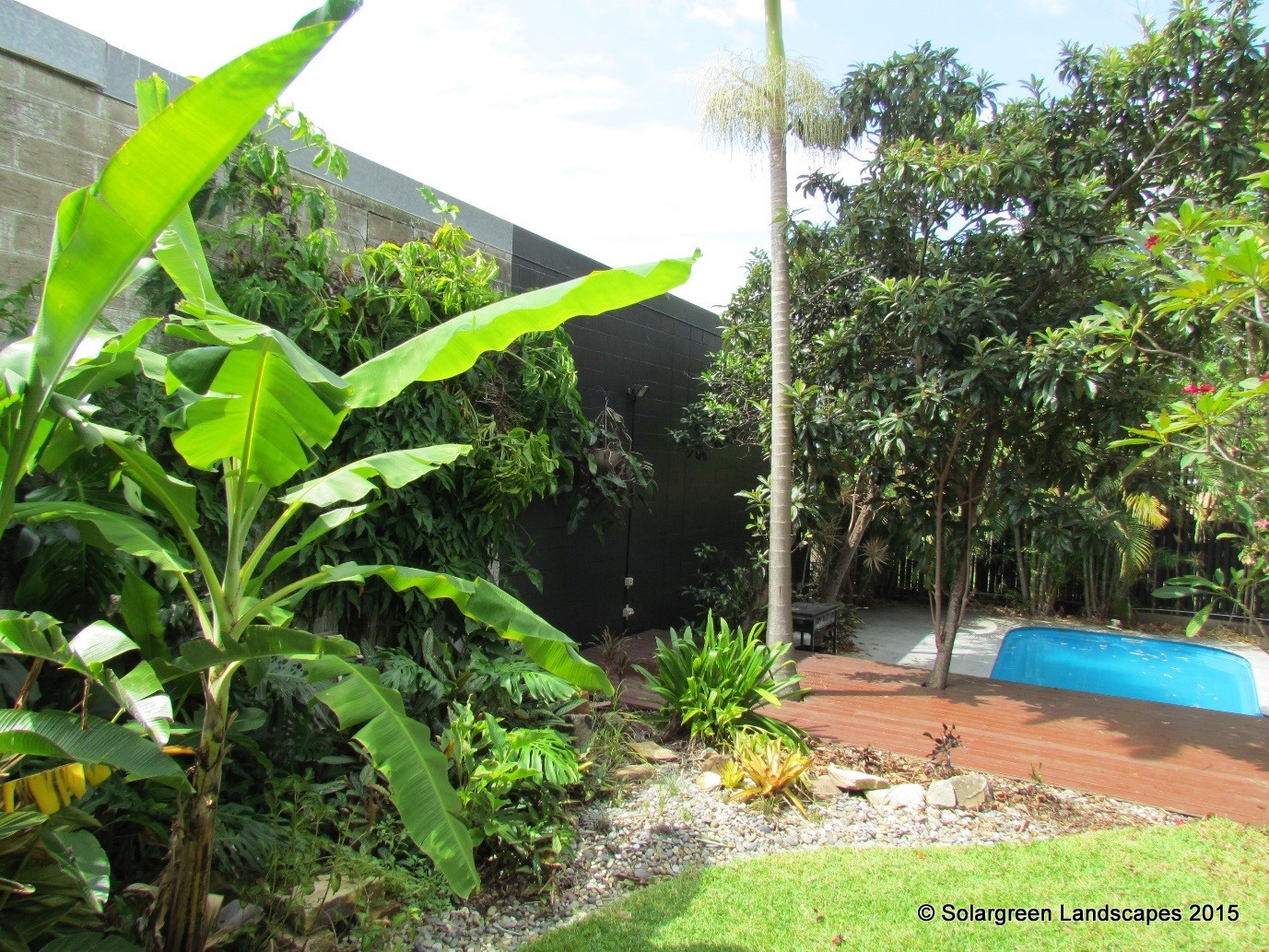(all images taken at one of Solargreen’s designed gardens located in West End)
Love or hate your garden, chances are you are going to have to get in there to mow and somehow maintain it sooner or later. You can let it go, but you may face a back breaking task later on. Or you can pay someone else to do it. Or you can spend most weekends mowing and edging, but will you shake that slave to your garden feeling?
Here at Solargreen we think there is a third better way. The following tips help you to design the work out of your garden that looks great, while still having your own very presentable patch of paradise. You can become the lazy expert!
Most gardens are a combination of lawns and garden beds. Lawns need constant mowing, particularly in summer. Garden beds need trimming and watering. Plants inexplicably die, droughts are a constant threat. The following tips should help reduce your workload by designing the work out of your garden, while making it look as good as you do!

No brush cutters were employed in creating this scene!
Edging out the work
Let’s start with edges. Unless you have all lawn or all garden, you will have edges. Edges are a great source of thankless work for gardeners. On one side is lawn, the other is garden. The lawn stands ready, its invading army of runners and rhizomes ready to jump, tunnel and break through the barriers to quickly turn your lovely garden into some kind of wild lawn.
For most residential gardens there are two kinds of edging that are worth the money. One is relatively expensive and the other won’t cost you much at all, except a little initial effort.
The more expensive option is Aluminium edging. Aluminium edging works similarly to plastic edging, but with the advantage of durability and sleek seamless lines. It comes in 100 and 75mm widths which is important if you are to stop grass runners both above and below ground. At around $50 a meter before installing, it is not cheap but if you add up all the weekends saved by not having to edge or pull grass out of your garden then it becomes worth the initial investment. If installed with the top edge close to ground level (around 5-10mm high) with most turf types you can mow over it without having to edge later.
The other edge alternative is the simple spade edge. Made by cutting the edge of the grass with a spade it takes a bit of work and can be harder to maintain if you have a runner grass type lawn such as couch.

Aluminium edging can save you valuable time and energy on edging if installed correctly. Just set your mower to the right height and most of your edging is done (turf shown is a buffalo grass).
Design the work out of it!
I don’t know anyone who likes brush cutting. When planning a lawn area, think on a higher plane. Think of the lawn edge as a bank next to a river of lawn, all sinuous curves with no jarring edges. If the mower can’t get to it, forget it! If you have fences or walls, consider screening them with planting, not only will they look better but you won’t have to edge along them.
If you have paths try manual edging. Despite looking like a medieval torture device a manual edger gives a much better result. For best results edge a few days after rain and before the mowing- this way the trimmings will be picked up by the mower.

Smooth flowing edges look great and mean less work.
Mulch it
Mulch is essential to any great garden. Not only does it prevent weeds, it keeps the ground cool, holds in moisture and promotes micro biological activity. When choosing a mulch pick one that has no small particles (say less than a centimeter square). These mulches are known as ‘no fines’ in the trade, due to an absence of fine particles. An example would be a clean wood chip mulch that is made from wood chips only, not leaves, dirt and other mystery ingredients. Mulches that have lots of fines not only break down faster, they can become ‘hydro static’- they can form a surface coat that can actually repel water.
You might be surprised to know that a good no fines wood chip mulch is not necessarily the most expensive. Many landscape supply places offer a ‘wood chip’ mulch for much less than more expensive pine, hoop pine and cypress varieties (cypress in particular can have lots of fines. If you can, visit the landscape supply place first to inspect the mulch ahead of purchasing. Tree loppers can also be a great source of inexpensive mulch, however again make sure it is mostly wood chip and not leaves and fine branches.
A good mulch depth is around 50-75mm, the key being to spread it evenly and avoid placing right up against tree and plant stems otherwise they can rot.
A little about stone mulches- as a general rule of thumb they are best avoided as they can make conditions too hot for plant life, particularly in summer. This disadvantage can however be used strategically in situations where plant growth may not be desirable (edges and drainage areas, for example), and on the south side of houses where there is very little sunlight. Generally it is not a great idea to have planting next to a house and under eves, so stone mulches can offer an attractive alternative.

Stone mulch that was recycled on site is used to keep plants and grass separated and assists drainage. Do not expect a lot of plant growth in a stone mulch, it gets way too hot for most plants.
Sneaky Trash Pile System
Just like your house, your garden will produce ‘waste’, and if you have room rather than throwing that waste away you can easily ‘harness the force’ and recycle it back into the soil, or use it as mulch.
If you have the room and like your gardening to be easy, then find a suitable screened, out-of-the-way area 2x3m to place your fronds, leaves and grass trimmings. The area can be screened off using subtropical vegetation such as gingers and heliconias, even a banana patch. The longer your ‘trash’ area is established the quicker things will start to break down with the build-up of beneficial organisms in the soil. Avoid using the area for kitchen scraps- they require composting.
A compost bin is the next in the effort spectrum, having an advantage that composts take kitchen scraps and generally are a speedier decomposition process. For a compost to work properly try to include a lot of ‘brown’ (leaves and fronds) and ‘green’ (lawn clippings) as well as your kitchen scraps. Mulching material through a shredder (see below) will speed up the process.
DIY mulch
For those with less room, or if you would like to use your garden trimmings as mulch, a small electric shredder is invaluable. The Ozito Silent Shredder is recommended as relatively inexpensive (around $300), and works very well with palm fronds and other tree trimmings. If you have a small amount of weeds you can also use your mower as a shredder, just lay them in a flat layer on the grass and run over a few times, taking care not to do too much at once and collect them in the catcher bag for use in composting. Remember though that mulching weeds that contain seeds and spreading them over your garden may result in more weeds. Try to pull weeds before they produce seeds and if you have weeds with seeds compost them as the heat of composting can kill the seeds. Avoid using pure grass clippings as mulch, of if you do, spread them thinly and again make sure they don’t contain seeds. Of course your homemade mulch might not be as good as pure wood chips, but you will be getting a good regular supply for free.
And finally a little bit about plant selections. The lazy expert will use native and subtropical ground covers as the back bone of the garden design, slotting in a few select special plants along the way as highlights and features. A good start is purchasing tube stock sized lomandras, dianellas (ask for short stemmed varieties), dieties and liriopes (the latter two are not native but are non-invasive). These strappy green plants will look great through drought periods and once established require very little maintenance. Purchasing as a tube stock not only is cheaper but results in a better plant for many of these native groundcovers. For a more tropical look, try the rhizomes- heliconias, gingers, and ornamental bananas. These plants will add texture and colour to the garden. They can spread, however a well-placed shovel cut and they can easily be pulled out and composted or given away. For extra showiness plant cordyline and dracaena canes- you can buy these or simply ask a friend for cuttings, just get a length of cane and place in some well drained ground, water until established. Happy Gardening!

Native ground covers (lomandra) on the left and rhizome running heliconias, gingers and bananas in the background make attractive, inexpensive landscape plants.
Useful links:
http://www.ozbreed.com.au/articles/mulch.html
http://www.ozbreed.com.au/articles/tips1.html



Comments are closed.